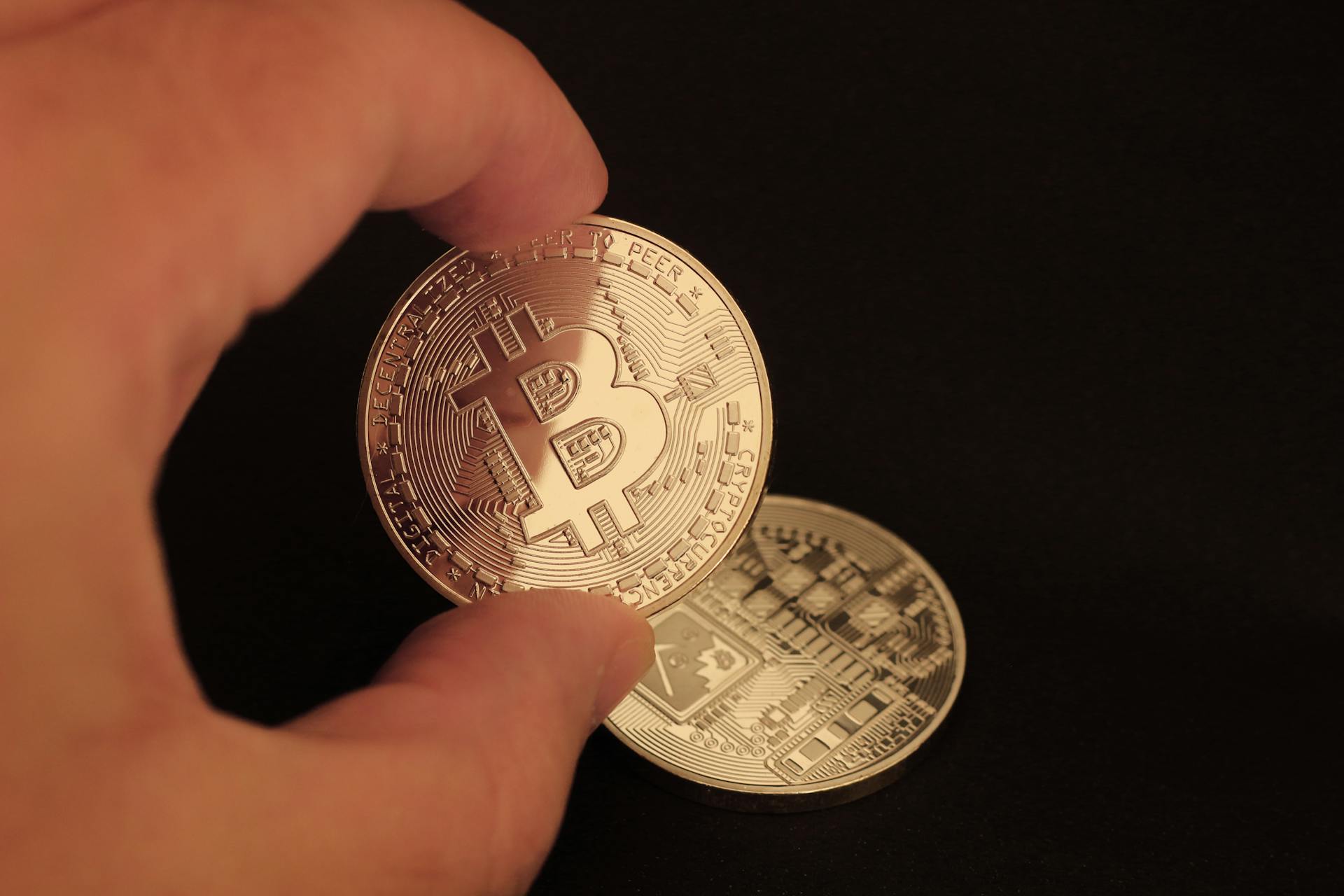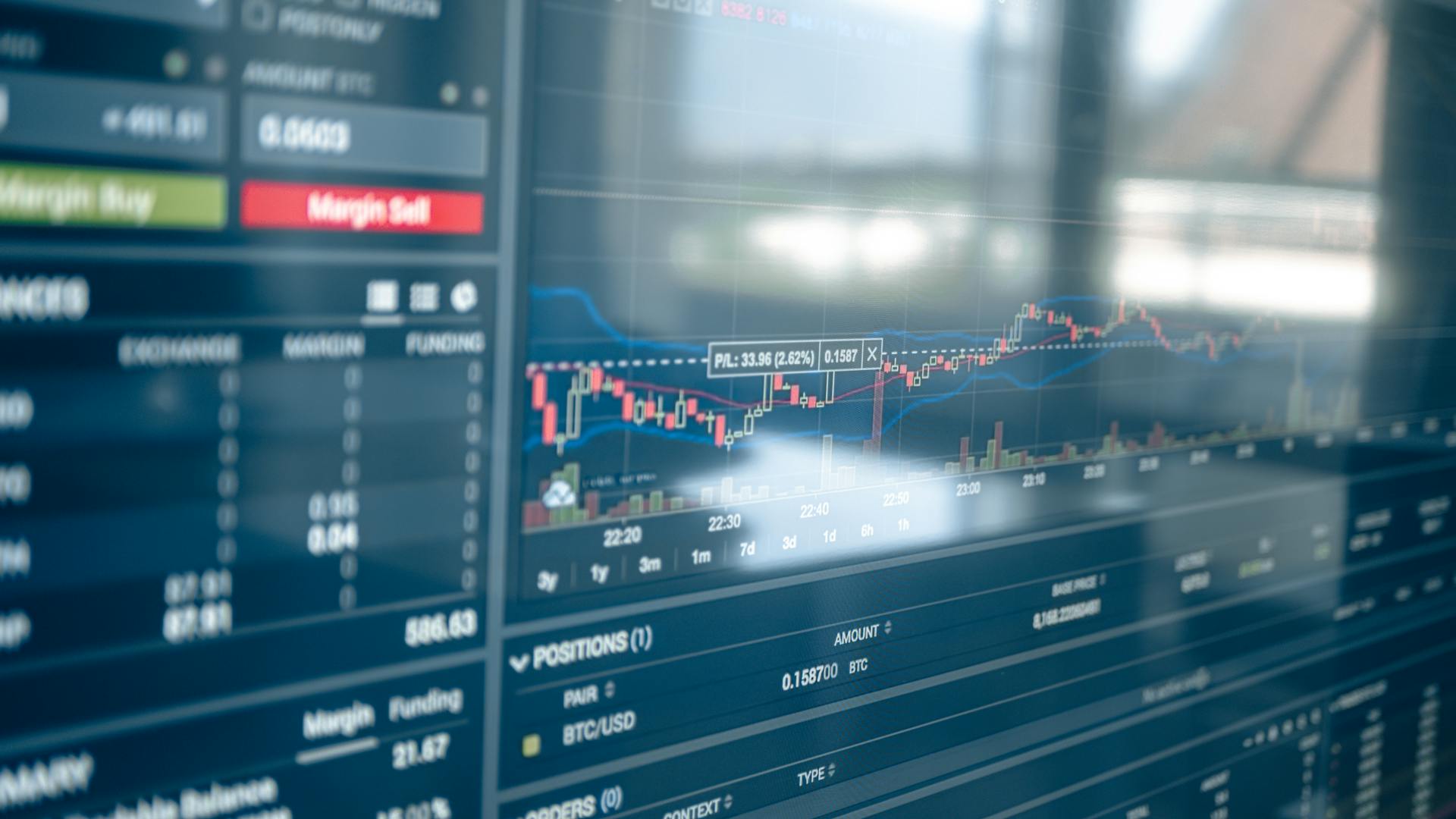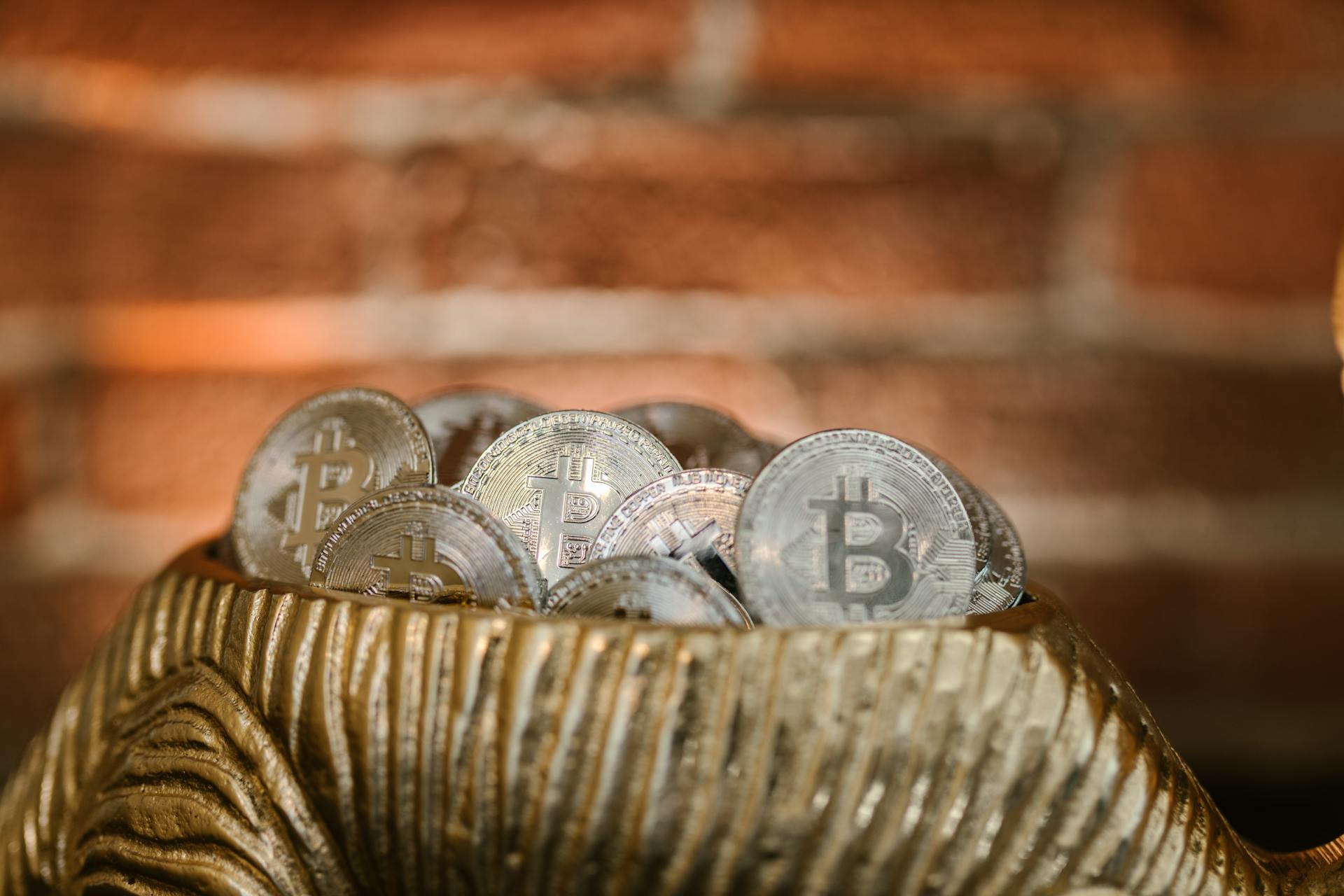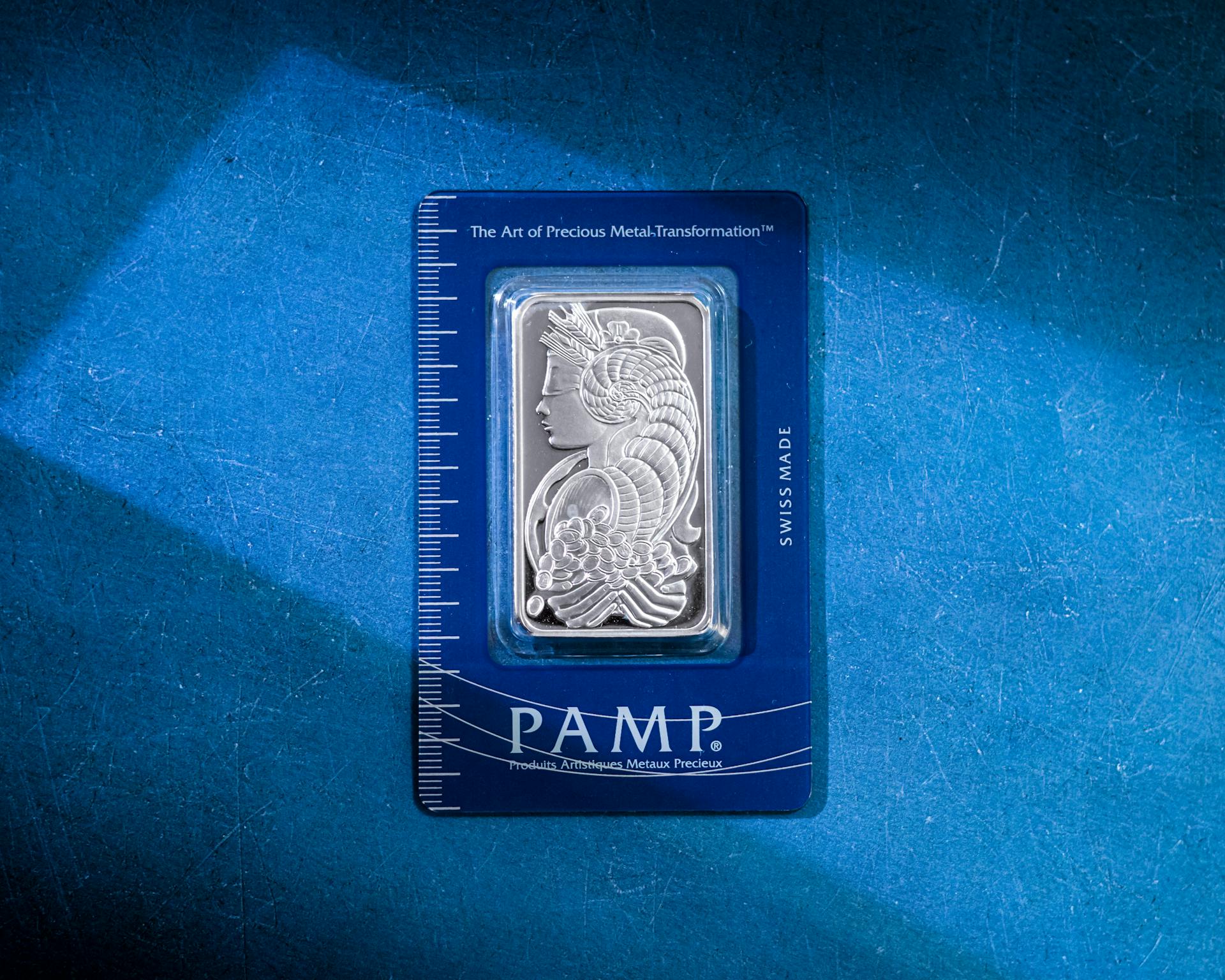
Rwa crypto coins are a type of digital asset that represents ownership in a real-world asset, such as a property or a piece of art.
These coins are created through a process called tokenization, which allows for the fractional ownership of a single asset. This means that instead of one person owning the entire asset, multiple people can own a portion of it.
Tokenization is made possible by the use of blockchain technology, which provides a secure and transparent way to record ownership and transactions. This allows for the creation of a digital token that represents ownership in the real-world asset.
Rwa crypto coins can be thought of as a way to democratize access to traditionally exclusive investments, making it possible for anyone to own a piece of a valuable asset.
You might enjoy: Digital Bolivar
Benefits and Advantages
RWA crypto coins offer a range of benefits and advantages that make them attractive to investors.
One big advantage is that they make assets easier to trade, available 24/7 on cryptocurrency exchanges, breaking free from traditional market hours.
RWA tokens bring transparency to the table, with blockchain tech providing a clear, unchangeable record of ownership, helping to prevent fraud and arguments over ownership.
This means lower costs for investors, making it more affordable to get into the game, by cutting out middlemen, paperwork, and legal fees.
Here are some of the key advantages of RWA crypto:
- Broader Access and Enhanced Liquidity: RWA crypto breaks down traditional investment blocks, democratizing access to formerly restricted assets.
- Improved Transparency and Security: The inherent transparency and security of blockchain tech ensure that transactions involving real-world assets crypto are immutable and secure.
- Innovative Asset Management: RWA crypto projects introduce innovative methods for managing and investing in assets, blending old and new approaches.
Stablecoins, a type of RWA, are helpful for individuals who want to send and receive fiat-valued currencies without going to banks, as they are pegged to the value of a traditional currency.
Tokenization of real-world assets also offers efficiency, as fractionalization of the asset will be possible, allowing people to have partial ownership using just their crypto wallets.
This enables more web3 users to lend and borrow, providing liquidity, and serving as collateral in DeFi protocols.
Tokenization Process
Tokenization boosts liquidity by allowing fractional ownership and easy asset transfer, making transactions smoother by cutting out intermediaries and lowering costs.
Tokenization creates digital tokens by dividing real-world assets into smaller, cheaper parts, letting more people join in and trade these pieces on digital platforms.
The next step in the process includes turning the asset's information into a digital token, embedding the data of the asset, including the value and ownership, within the token's metadata.
Blockchain tech ensures that all transactions are transparent and secure, cutting down on fraud and errors. This creates clear and unchangeable records of ownership, boosting investor trust.
Partnerships between stakeholders in the ecosystem, such as CEXs and DEXs, are crucial in promoting this innovative financial model, facilitating the trading of tokenized assets and functioning as a marketing engine.
The market price, performance history, and physical condition of the asset are among the factors that influence the value of a RWA, with big time assets like real estate requiring undisputed legal ownership, documented by deeds or invoices.
See what others are reading: Token or Coin Crypto
Types of Tokens
Tokenizing real-world assets has opened up a wide range of investment opportunities, but what types of tokens are available? Tokenization of land and luxury assets, such as real estate and precious metals, has been a game-changer, granting them upgraded market fluidity and wider accessibility.
Tokenization of art and collectibles has also introduced shared ownership possibilities, making once-exclusive items accessible to a broader audience. This has been made possible by merging blockchain with the world of art and collectibles.
Here are some examples of the diverse types of RWA tokens and RWA coins:
By tokenizing these types of assets, investors can now buy into high-value markets like real estate and fine art, making financial opportunities more inclusive and accessible.
Diverse Types and Their Integration
Real-world asset (RWA) tokens are becoming increasingly popular, and for good reason. They allow for the tokenization of real-world assets, making it easier to trade and invest in things like real estate and art.
The types of RWAs that can be tokenized are diverse and varied. They include land and luxury assets, art and collectibles, innovative financial and creative assets, and even financing and insuring with new tech.
Tokenization has breathed new life into real estate and precious metals, granting them upgraded market fluidity and wider accessibility. This shift has opened up investment options previously limited by traditional barriers.
Readers also liked: World Liberty Financial Crypto Coin
Art and collectibles can also be tokenized, introducing shared ownership possibilities and making once-exclusive items accessible to a broader people. This has the potential to revolutionize the way we think about ownership and investment.
Here are some examples of the diverse types of RWAs and their integration:
By tokenizing these types of assets, we can create new investment opportunities and make it easier for people to invest in things that were previously out of reach. This has the potential to democratize access to investment and create a more inclusive financial system.
Take a look at this: How to Invest in All Cryptocurrencies
Native vs Non-Native Tokens
Non-native tokens are created on existing blockchains like Ethereum or Solana, leveraging their security and infrastructure, which is important for RWAs.
These tokens rely on the performance and limitations of their host blockchains, but offer lower development costs and faster deployment.
USDT (Tether) on Ethereum is a non-native token used for various transactions, including those involving tokenized RWAs.
Native tokens, on the other hand, offer tailored functionalities specific to the needs of the tokenized asset.
Developing and maintaining a native blockchain involves higher costs and independent security measures, making it a more resource-intensive option.
Non-native tokens provide the convenience of existing infrastructure, while native tokens give full ecosystem control.
It's essential to consider these differences when choosing between non-native and native tokens, as they influence the security, scalability, and cost-effectiveness of the tokenization process.
Smart Contracts and DeFi
Smart contracts are the backbone of RWAs in DeFi, automating transactions and ensuring seamless operation and security of digital agreements. They can automatically transfer ownership of tokenized assets, manage rental agreements, and hold funds in escrow until transaction conditions are met.
One of the significant benefits of smart contracts is their ability to reduce processing times and administrative overhead, streamlining asset management. By automating transactions, they also increase efficiency, cost savings, and security.
For your interest: Bnb Smart Chain Bep20 Bitpay
For example, MakerDAO uses tokenized real-world assets to back its stablecoin, DAI, enhancing stability and reducing volatility. Similarly, platforms like Maple Finance and Goldfinch integrate RWAs for lending and borrowing, making credit more accessible in the DeFi space.
Here are some DeFi protocols that are successfully integrating RWAs:
- MakerDAO: uses tokenized real-world assets to back its stablecoin, DAI
- Maple Finance: connects institutional capital markets to crypto by integrating RWAs for lending and borrowing
- Goldfinch: aims to bring decentralized credit to the real world using RWAs as collateral
- Creditcoin: facilitates decentralized credit transactions by creating a public ledger of credit activities
Smart Contracts
Smart contracts are self-executing codes on blockchains like Ethereum, composed of state variables and functions. They automate the creation, management, and transfer of tokenized assets.
Smart contracts can automatically transfer the ownership of a tokenized real estate property once payment conditions are met. They can also manage rental agreements by automating the process for payments.
In escrow services, smart contracts hold the funds until transaction conditions are fulfilled, providing a secure mechanism for large asset transactions. This ensures that all parties involved can trust the process.
Smart contracts offer potentially massive benefits, like increased efficiency, cost savings, and enhanced security. They reduce processing times and administrative overhead, streamlining asset management.
However, smart contracts can also come with potential code vulnerabilities and varying legal recognition across jurisdictions. Ensuring robust auditing and compliance with legal standards becomes crucial for successfully implementing RWA tokenization projects.
The Role in DeFi
Smart contracts play a crucial role in the integration of real-world assets (RWAs) into decentralized finance (DeFi). By tokenizing RWAs, DeFi platforms can offer fractional ownership and easier transferability, making high-value assets more accessible to a broader range of investors.
RWAs can be used as collateral for loans, integrating them smoothly into the financial ecosystem. This is achieved through smart contracts that automate the process, reducing processing times and administrative overhead.
MakerDAO uses tokenized real-world assets to back its stablecoin, DAI, enhancing stability and reducing volatility. In July 2024, they announced a $1 billion investment in tokenized U.S. Treasury products.
RWAs are increasingly integrated into DeFi platforms, which is a notable development. By tokenizing real-world assets, these platforms create new investment opportunities and make traditionally exclusive markets more accessible.
Creditcoin facilitates decentralized credit transactions by creating a public ledger of credit activities. This ledger can be checked against real-world financial data to boost transparency and reliability in credit transactions.
Check this out: Crypto Coin Ledger
Maple Finance connects institutional capital markets to crypto by integrating RWAs for lending and borrowing. Institutional borrowers can get liquidity through decentralized lending pools on Maple Finance.
Here are some examples of DeFi protocols that have successfully integrated RWAs:
- MakerDAO: uses tokenized real-world assets to back its stablecoin, DAI
- Creditcoin (CTC): facilitates decentralized credit transactions
- Maple Finance (MPL): connects institutional capital markets to crypto
- Goldfinch (GFI): brings decentralized credit to the real world using RWAs as collateral
These examples showcase innovative approaches to bridge traditional finance with blockchain technology.
Frax Finance
Frax Finance is a decentralized protocol with three subprotocols, each containing a stablecoin. These stablecoins are $FRAX, a dollar-pegged asset, and Frax Price Index ($FPI) and FraxEther ($frxETH), pegged to a basket of consumer goods and $ETH respectively.
The third subprotocol, FRAX v3, recently launched and claims to utilize an RWA strategy that yields returns close to the Interest Rate on Reserve Balances (IORB) rate with minimal duration risk. This strategy is designed to provide stability and returns to users.
The RWA offered by FRAX v3 include short-dated U.S. treasury bills, Federal Reserve Overnight Repurchase Agreements, USD deposited at Federal Reserve Bank master accounts, and select shares of money market mutual funds. These options provide a range of investment choices for users.
A strong community and active governance have led many to speculate about an upcoming airdrop campaign.
Expand your knowledge: Crypto Coin Exchange Rate
Chainlink (Link)
Chainlink (LINK) is a vital oracle connecting real-world data to the blockchain, serving as an essential infrastructure component for real-world asset applications.
Miles sees Chainlink as a blue-chip asset in his portfolio, offering exposure to the RWA sector indirectly while providing long-term growth potential.
Chainlink's role in the RWA sector is significant, allowing it to tap into its growth potential.
As an indirect exposure to the RWA sector, Chainlink offers a unique investment opportunity for those looking to diversify their portfolio.
Readers also liked: World Crypto Coin
Prominent Examples and Protocols
Integrating real-world assets (RWAs) into the crypto ecosystem has opened doors to innovative financial products and investment opportunities. The RWA sector is still in its early stages, but it's already showing promise.
Miles identifies Red Belly as a promising upcoming protocol that's poised to further expand the RWA landscape. Lingo, a protocol focused on real estate-backed rewards tokens, is another exciting application of RWA technology.
Red Belly and Lingo are just a couple of examples of the many innovative protocols emerging in the RWA sector. These protocols have the potential to unlock new investment opportunities and financial products.
Consider reading: Bitcoin Protocol News
Prominent Examples and Protocols

The RWA sector is indeed exciting, with a range of innovative financial products and investment opportunities emerging.
One of the prominent examples of RWAs in crypto is integrating real-world assets into the ecosystem, paving the way for new financial products and investment opportunities.
Red Belly is a promising upcoming protocol that's poised to expand the RWA landscape.
Lingo is a protocol focused on real estate-backed rewards tokens, showcasing an exciting application of RWA technology.
You might like: Are Cryptocurrencies a Good Investment
Ono Finance (ONO)
Ono Finance (ONO) is a leading platform in the RWA space, offering users the ability to earn a yield on US treasuries and dollar money markets across multiple chains.
Its focus on regulatory compliance has helped attract investor attention, making it a notable player in the industry.
With innovative features like global markets, Ono Finance has become a go-to destination for those looking to diversify their portfolios.
By providing access to multiple chains, Ono Finance has made it easier for users to manage their investments and stay ahead of the curve.
Its commitment to regulatory compliance has given investors confidence in the platform, leading to its growing popularity.
For more insights, see: Finance Coin Crypto
Pendle Finance (Pendle)
Pendle Finance is a hub for yield from RWA protocols on the blockchain. It provides financial products like the Reward Asset Financial Product.
Pendle Finance lets liquidity providers earn yield across different chains, making it an indirect proxy for the RWA sector. This is a unique feature that sets it apart from other platforms.
Pendle Finance offers a flexible platform that allows users to earn yield in various ways. Its financial products cater to different needs and preferences.
The platform's navigation menu includes options like News, Live News, Markets, Academy, and Portfolio. These sections provide valuable information and resources for users.
Expand your knowledge: Earn Crypto Coins
Frequently Asked Questions
Which coin will reach $1 in 2024?
According to our analysis, Wall Street Pepe, Solaxy, and Best Wallet Token are the top cryptos predicted to hit $1 in 2024. Check out our guides and reviews for more in-depth research and expert insights.
Where can I buy Rwa coins?
You can buy RWA tokens on decentralized exchanges, with PancakeSwap (v2) being a popular option. Trade RWA/WBNB on PancakeSwap to access the RWA market.
What is the RWA ecosystem in crypto?
The RWA ecosystem is a network of companies and platforms enabling secure, compliant, and efficient management of tokenized assets in the crypto space. It highlights key players driving the adoption of real-world asset tokenization.
Which crypto has real world use?
Which crypto has real-world use?" Ethena is a top crypto project with real-world applications, offering a fresh take on stablecoins.
Sources
- https://coinranking.com/coins/rwa
- https://www.bitdegree.org/crypto/tutorials/what-is-rwa-in-crypto
- https://guarda.com/academy/crypto/what-is-rwa-in-crypto/
- https://bitpinas.com/learn-how-to-guides/real-world-assets-rwa-airdrop/
- https://coinpedia.org/news/top-5-real-world-assets-rwa-cryptos-poised-for-explosive-growth-before-bitcoin-halving/
Featured Images: pexels.com


